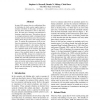Free Online Productivity Tools
i2Speak
i2Symbol
i2OCR
iTex2Img
iWeb2Print
iWeb2Shot
i2Type
iPdf2Split
iPdf2Merge
i2Bopomofo
i2Arabic
i2Style
i2Image
i2PDF
iLatex2Rtf
Sci2ools
EMNLP
2010
2010
What a Parser Can Learn from a Semantic Role Labeler and Vice Versa
In many NLP systems, there is a unidirectional flow of information in which a parser supplies input to a semantic role labeler. In this paper, we build a system that allows information to flow in both directions. We make use of semantic role predictions in choosing a single-best parse. This process relies on an averaged perceptron model to distinguish likely semantic roles from erroneous ones. Our system penalizes parses that give rise to low-scoring semantic roles. To explore the consequences of this we perform two experiments. First, we use a baseline generative model to produce n-best parses, which are then re-ordered by our semantic model. Second, we use a modified version of our semantic role labeler to predict semantic roles at parse time. The performance of this modified labeler is weaker than that of our best full SRL, because it is restricted to features that can be computed directly from the parser's packed chart. For both experiments, the resulting semantic predictions...
EMNLP 2010 | Low-scoring Semantic Roles | Natural Language Processing | Semantic Role Labeler | Semantic Roles |
| Added | 11 Feb 2011 |
| Updated | 11 Feb 2011 |
| Type | Journal |
| Year | 2010 |
| Where | EMNLP |
| Authors | Stephen A. Boxwell, Dennis Mehay, Chris Brew |
Comments (0)

